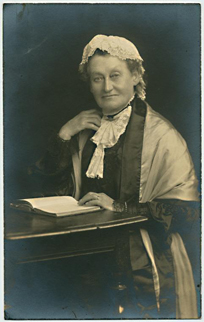Girls on top
In People news
Follow this topic
Bookmark
Record learning outcomes
Unlike the male candidates on the Pharmaceutical Society's examination pass list, women had not been allowed to apply for membership of the organisation
Steve Ainsworth looks at recognition problems faced by the first women in pharmacy and finds one woman pharmacist who became famous in another field
Two questions that might tax the minds of even the most ardent collector of obscure
facts are: €What's the connection between snooker and pharmacy?€, and, €Who was Britain's first female pharmacist?€
Of course, answering the second question depends on one's exact definition of 'pharmacist'. It's an impossible one to answer if one includes the 'wise women' of the distant past, or female apothecaries.
But if an answer must be found, then several names might fit the bill: Fanny Deacon, Alice Vickery, Isabella Clarke or Rose Minshull, for example. These ladies were not, however, exactly welcomed with open arms by the pharmaceutical profession's elite.

Alice Vickery:
pharmaceutical polymath
In the 1860s, when England's first female doctor Elizabeth Garrett (later Mrs Elizabeth Garrett Anderson) began attending lectures at the Pharmaceutical Society's School of Pharmacy, the Society's Council reacted by passing a resolution banning women from the premises.
Register
The Pharmacy Act of 1868 required all practising pharmacists to register with the Pharmaceutical Society.
To the dismay of many male members of the Society, 223 women (some 2 per cent of the total) found their way onto the register, having qualified for inclusion because they were already in business before the cut-off date of August 1, 1868.
Women were, however, able to take the Society's exams alongside their male counterparts. Frances Deacon (née Potter) of Kibworth Beauchamp, Leicestershire, became the first women to pass the 'Modified' exam after the 1868 Act.
In 1873, Alice Vickery was the first woman to qualify as a chemist and druggist by passing the Society's 'Minor' exam.
Yet if any woman deserves to be memorialised as Britain's first female pharmacist it is surely the remarkable Alice Vickery (1844-1929). Earlier in 1873, she had qualified as a midwife. In 1880 she also became one of the first women in Britain to qualify as a medical practitioner.
As if that were not enough, Alice was also a prominent early feminist, and an active promoter (and practitioner) of free love, contraception and women's rights.
She was, successively, a member of the National Society for Women's Suffrage, the Women's Social and Political Union and the Women's Freedom League. After the death of her common-law husband Dr Charles Drysdale in 1907, Vickery succeeded him as President of the Malthusian League, an organisation dedicated to promoting family planning.
In the meantime, unlike the male candidates on the Pharmaceutical Society's examination pass list, women had not been allowed to apply for membership of the organisation. Though they had qualified as pharmacists, they had no rights in the Society.
Unsurprisingly, that state of affairs had raised the hackles of some doughty Victorian women.
Passes
Isabella Clarke and Rose Minshull had both passed the Society's Preliminary, Minor and Major exams. From 1875 they both made repeated applications for membership of the Society and were rejected.
The Annual General Meeting of 1878 approved a motion, albeit by just two votes, that it was undesirable for women to be admitted to the Society. The following year, however, the Society's Council grudgingly finally agreed that Clarke and Minshull should become members.
Reportedly, some council members simply gave in to end the debate €“ €to avoid further agitation€ as one put it.
Symbolic
Yet the change turned out to be largely symbolic. In the following decades, the number of women on the statutory register actually declined.
By 1905, there were only 195 female pharmacists on the register, just 1.2 per cent of the 16,000 total.
Not until the second half of the 20th century would the seeds that had been sown by 19th-century female pioneers begin to bear real fruit.
In 1918, Margaret Buchanan became the first female member of council. In 1924, Agnes Borrowman joined the Society's board of examiners.
In 1947, Jean Kennedy Irvine became the first of many female presidents of the Pharmaceutical Society.
By then, one in 10 pharmacists were female. This had grown to 18 per cent by 1959, and by the mid-1980s over a third of pharmacists were women.
And it has not stopped there. Since the turn of the 21st century, there have been more women than men on the register; it has taken a very long time, but girls really are now on top.
Raised bar
Yet, being female was not the only historical handicap to becoming a pharmacist. Being both black and female raised the bar even higher.
When Una Atwell was born in Trinidad in 1910 there was little doubt that she would one day become a chemist like her father and join him in his shop. Una did indeed train as a pharmacist. But in her early thirties, her musical hobby began to take her life in an entirely different direction.
Using her middle name, Winifred, the Trinidadian piano-player became a world- wide sensation, ending up selling some 20 million records.
Her 1954 hit 'Let's have another party' was the first piano instrumental to reach number one in the UK Singles Chart.
And that connection between snooker and pharmacy?
Well, it was Winifred Atwell's 1952 recording of her signature tune 'Black and white rag' which became famous once again in the 1970s as the theme tune for BBC television's popular snooker programme Pot Black.
